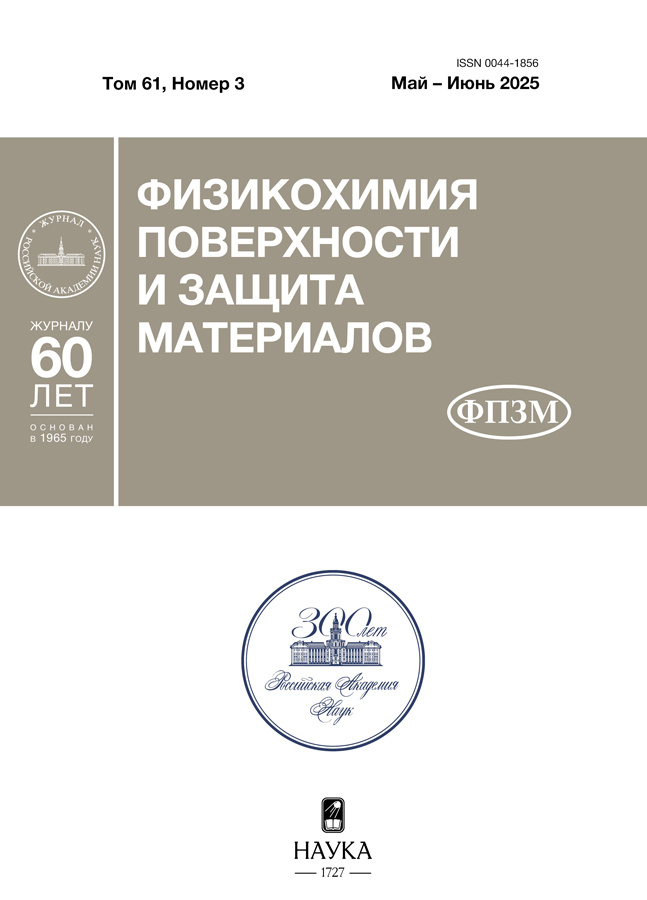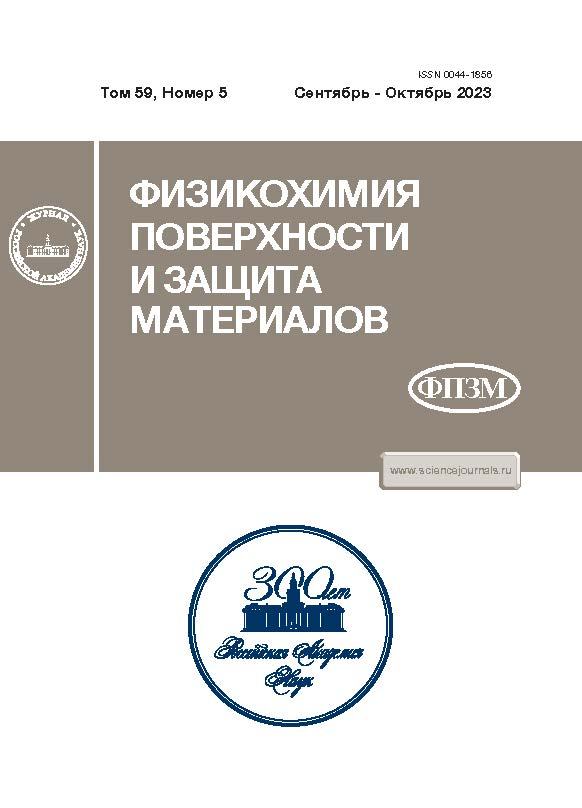Селективные сорбенты на основе 2-гидроксиэтилметакрилата и диметакрилата этиленгликоля, модифицированные борной кислотой в качестве аффинного лиганда для глюкозы
- Авторы: Гаркушина И.С.1, Панюта А.С.1, Морозова П.Ю.1, Осипенко А.А.1
-
Учреждения:
- Институт высокомолекулярных соединений Российской академии наук
- Выпуск: Том 59, № 5 (2023)
- Страницы: 506-516
- Раздел: ФИЗИКО-ХИМИЧЕСКИЕ ПРОЦЕССЫ НА МЕЖФАЗНЫХ ГРАНИЦАХ
- URL: https://cardiosomatics.ru/0044-1856/article/view/663928
- DOI: https://doi.org/10.31857/S0044185623700614
- EDN: https://elibrary.ru/VFENJM
- ID: 663928
Цитировать
Полный текст
Аннотация
Разработан метод синтеза гранульных полимерных сорбентов, обладающих аффинными по отношению к глюкозе сорбционными центрами, сформированными молекулами борной кислоты, на основе 2-гидроксиэтилметакрилата и этиленгликоль диметакрилата. Установлены участие борной кислоты в качестве дополнительного сшивающего агента, влияние количества введенного лиганда на морфологию поверхности гранул и физико-химические свойства полимерных сорбентов. Выявлено, что данная модификация полимерной матрицы способствует увеличению сродства сорбционной поверхности и ее адсорбционной способности к связыванию глюкозы в динамическом режиме, а также высокой селективности по сравнению с сорбцией структурного аналога – фруктозы. В дальнейшем это может быть использовано при разработке метода выделения глюкозы из многокомпонентного раствора и сорбционного метода разделения сахаров.
Об авторах
И. С. Гаркушина
Институт высокомолекулярных соединений Российской академии наук
Email: irin-g16@yandex.ru
Россия, 199004, Санкт-Петербург, В.О., Большой пр., 31
А. С. Панюта
Институт высокомолекулярных соединений Российской академии наук
Email: irin-g16@yandex.ru
Россия, 199004, Санкт-Петербург, В.О., Большой пр., 31
П. Ю. Морозова
Институт высокомолекулярных соединений Российской академии наук
Email: irin-g16@yandex.ru
Россия, 199004, Санкт-Петербург, В.О., Большой пр., 31
А. А. Осипенко
Институт высокомолекулярных соединений Российской академии наук
Автор, ответственный за переписку.
Email: irin-g16@yandex.ru
Россия, 199004, Санкт-Петербург, В.О., Большой пр., 31
Список литературы
- Ning H. et al. // J. Chromatogr. A. 2022. V. 1671. P. 462994.
- Hasanah A.N. et al. // J. Chem. Hindawi Limited. 2020. V. 2020. ID 7282415
- Tu X. et al. // Talanta. 2021. V. 226. P. 122142.
- Alipour S. et al. // J. Mater. Res. Technol. 2021. V. 12. P. 2298–2306.
- Eivazzadeh-Keihan R. et al. // TrAC Trends Anal. Chem. 2021. V. 141. P. 116291.
- Xu R. et al. // J. Chromatogr. A. 2021. V. 1635. P. 461707.
- Hu Z., Wang X., Chen X. // Anal. Chim. Acta. 2020. V. 1112. P. 16–23.
- Gheybalizadeh H., Hejazi P. // React. Funct. Polym. 2022. V. 171. P. 105152.
- Amorim M.S., Sales M.G.F., Frasco M.F. // Biosens. Bioelectron. 2022. V. 10. P. 100131.
- Li M. et al. // Kexue Tongbao/Chinese Science Bulletin. 2019. V. 64. № 13. P. 1321–1329.
- Askin S., Kizil S., Bulbul Sonmez H. // React. Funct. Polym. 2021. V. 167. P. 105002.
- Bayraktaroglu S., Kizil S., Bulbul Sonmez H. // J. Environ. Chem. Eng. 2021. V. 9. № 5. P. 106002.
- Sulejmanović J. et al. // Chemosphere. 2022. V. 296. P. 133971.
- Wang H.H., Shyr T.W., Hu M.S. // J. Appl. Polym. Sci. 1999. V. 74. № 13. P. 3046–3052.
- Prosanov I.Y. et al. // Mater. Today Commun. 2018. V. 14. P. 77–81.
- Hong X. et al. // J. Appl. Polym. Sci. 2021. V. 138. № 47.
- Vedelago J. et al. // Sci. Reports. 2021. V. 11. № 1. P. 1–14.
- Belcher R., Tully G.W., Svehla G. // Anal. Chim. Acta. 1970. V. 50. № 2. P. 261–267.
- Dawber J.G., Matusin D.H. // J. Chem. Soc. Faraday Trans. 1982. V. 78. № 8. P. 2521–2528.
- Crabb W.D., Mitchinson C. // Trends Biotechnol. 1997. V. 15. № 9. P. 349–352.
- Kuznetsov B.N. et al. // Катализ в промышленности. 2017. V. 17. № 6. P. 543–553. (In Russ.).
- Dupont H. et al. // Macromolecules. 2021. V. 54. № 11. P. 4945–4970.
- Yang Y. et al. // Frontiers in Pharmacology. 2017. V. 8. № MAY. P. 287.
- Willaman J.J., Davison F.R. // J. Agric. Res. 1924. V. 28. № 5. P. 479–487.
- Umpleby R.J. et al. // Journal of Chromatography B: Analytical Technologies in the Biomedical and Life Sciences. 2004. V. 804. № 1. P. 141–149.
- Hinz C. // Geoderma. 2001. V. 99. № 3–4. P. 225–243.
- Freundlich H. // Zeitschrift für Phys. Chemie. 1907. V. 57U. № 1. P. 385–470.
- Ebadi A., Soltan Mohammadzadeh J.S., Khudiev A. // Adsorption. 2009. V. 15. № 1. P. 65–73.
- Ebadi A., Soltan Mohammadzadeh J.S., Khudiev A. // Chem. Eng. Technol. 2007. V. 30. № 12. P. 1666–1673.
- Krishna Kumar A.S., Jiang S.J., Tseng W.L. // J. Mater. Chem. A. 2015. V. 3. № 13. P. 7044–7057.
- Malarvizhi R., Sulochana N. // J. Environ. Prot. Sci. 2008. V. 2. P. 40–46.
- Liu Y. // Colloids Surfaces A Physicochem. Eng. Asp. 2006. V. 274. № 1–3. P. 34–36.
- Giles C.H., Smith D., Huitson A. // J. Colloid Interface Sci. 1974. V. 47. № 3. P. 755–765.
- Boyd G.E., Adamson A.W., Myers L.S. // J. Am. Chem. Soc. 1947. V. 69. № 11. P. 2836–2848.
- Lagergren S. // Springer-Verlag. 1907. V. 2. № 1. P. 15.
Дополнительные файлы


















